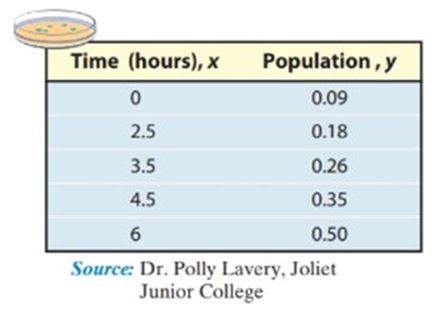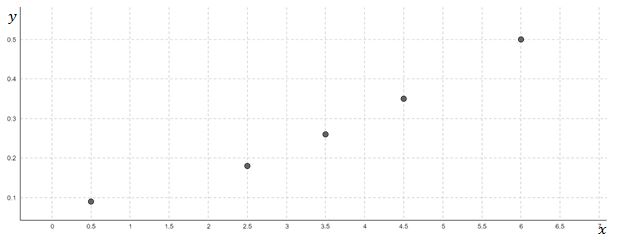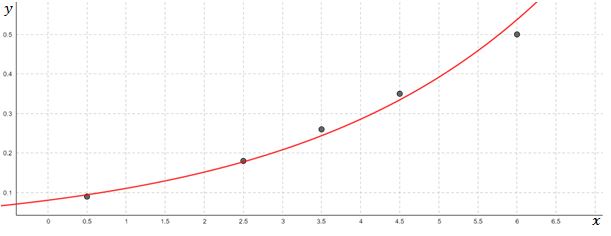
Concept explainers
Biology A strain of E-coli Beu 397-recA441 is placed into a nutrient broth at Celsius and allowed to grow. The following data are collected. Theory states that the number of bacteria in the petri dish will initially grow according to the law of uninhibited growth. The population is measured using an optical device in which the amount of light that passes through the petri dish is measured.

(a) Draw a
(b) Using a graphing utility, build an exponential model from the data.
(c) Express the function found in part (b) in the form .
(d) Graph the exponential function found in part (b) or (c) on the scatter diagram.
(e) Use the exponential function from part (b) or (c) to predict the population at hours.
(f) Use the exponential function from part (b) or (c) to predict when the population will reach .
To answer: The questions based on the given data in the table.
Answer to Problem 1AE
a. Scatter diagram.
Explanation of Solution
Given:
Table:
| Time (hours), | Population, |
| 0 | |
| 6 |
Calculation:
a. Scatter diagram.
Enter the data into the graphical utility, the time in and the population in , we obtain the scatter diagram as shown below.

To answer: The questions based on the given data in the table.
Answer to Problem 1AE
b. ;
Explanation of Solution
Given:
Table:
| Time (hours), | Population, |
| 0 | |
| 6 |
Calculation:
b.
The exponential function is of the form . Using the option of in the form , where and , proceed as follows:
;
To answer: The questions based on the given data in the table.
Answer to Problem 1AE
c.
Explanation of Solution
Given:
Table:
| Time (hours), | Population, |
| 0 | |
| 6 |
Calculation:
c.
To express in the form , where and , proceed as follows:
When , we find .
This leads to,
Therefore, .
Since, ; .
We find that and .
Taking log of the equation , we get,
As a result, .
To answer: The questions based on the given data in the table.
Answer to Problem 1AE
d. Graph.
Explanation of Solution
Given:
Table:
| Time (hours), | Population, |
| 0 | |
| 6 |
Calculation:
d.
See Figure 2 for the graph of the exponential function of best fit.

To answer: The questions based on the given data in the table.
Answer to Problem 1AE
e.
Explanation of Solution
Given:
Table:
| Time (hours), | Population, |
| 0 | |
| 6 |
Calculation:
e.
Using the function found in part-b, the population at hours can be predicted as,
This prediction exceeds the population at 6 hours.
To answer: The questions based on the given data in the table.
Answer to Problem 1AE
f. After hours.
Explanation of Solution
Given:
Table:
| Time (hours), | Population, |
| 0 | |
| 6 |
Calculation:
f.
Using the exponential form obtained in part-b, the time at which the population will reach can be obtained as,
Applying logarithm on both sides,
Therefore, after hours, the population will reach .
Want to see more full solutions like this?
Chapter 6 Solutions
College Algebra Plus MyLab Math with eText -- Access Card Package (10th Edition) (Sullivan & Sullivan Precalculus Titles)
Additional Math Textbook Solutions
University Calculus
Elementary & Intermediate Algebra
Elementary Statistics (13th Edition)
Finite Mathematics for Business, Economics, Life Sciences and Social Sciences
Basic College Mathematics
- 9:43 AS く Akbar © Printed in the United States 15) Scale: 1 cmal unit on both axes .ill 64% The graph above shows a straight line QT intersecting the y-axis at T. i State the co-ordinates of T. ii Calculate the gradient of QT 16) iii Determine the equation of QT. A (-1, 9) ||| i L Г (5 marks)arrow_forwardPls help.arrow_forwardPls help.arrow_forward
- eric pez Xte in z= Therefore, we have (x, y, z)=(3.0000, 83.6.1 Exercise Gauss-Seidel iteration with Start with (x, y, z) = (0, 0, 0). Use the convergent Jacobi i Tol=10 to solve the following systems: 1. 5x-y+z = 10 2x-8y-z=11 -x+y+4z=3 iteration (x Assi 2 Assi 3. 4. x-5y-z=-8 4x-y- z=13 2x - y-6z=-2 4x y + z = 7 4x-8y + z = -21 -2x+ y +5z = 15 4x + y - z=13 2x - y-6z=-2 x-5y- z=-8 realme Shot on realme C30 2025.01.31 22:35 farrow_forwardUse Pascal's triangle to expand the binomial (6m+2)^2arrow_forwardListen A falling object travels a distance given by the formula d = 6t + 9t2 where d is in feet and t is the time in seconds. How many seconds will it take for the object to travel 112 feet? Round answer to 2 decimal places. (Write the number, not the units). Your Answer:arrow_forward
- Algebra & Trigonometry with Analytic GeometryAlgebraISBN:9781133382119Author:SwokowskiPublisher:Cengage
 Big Ideas Math A Bridge To Success Algebra 1: Stu...AlgebraISBN:9781680331141Author:HOUGHTON MIFFLIN HARCOURTPublisher:Houghton Mifflin Harcourt
Big Ideas Math A Bridge To Success Algebra 1: Stu...AlgebraISBN:9781680331141Author:HOUGHTON MIFFLIN HARCOURTPublisher:Houghton Mifflin Harcourt

